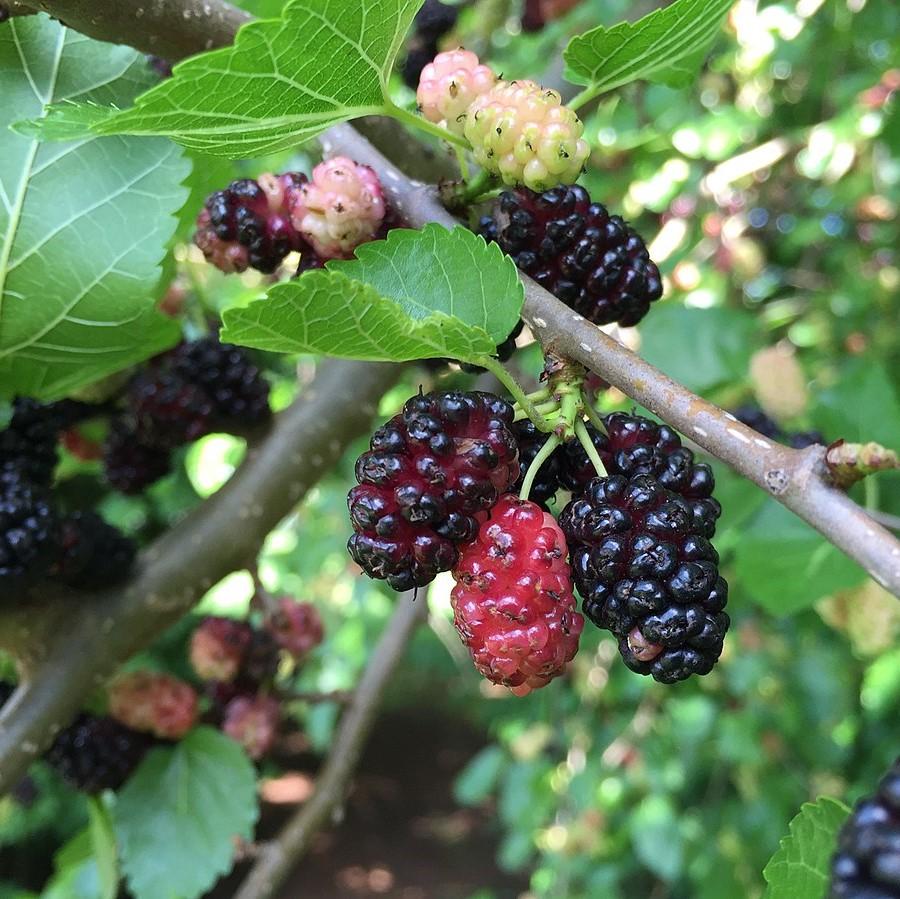Red Mulberry
Morus rubra
-
We currently have 0 available.
- Coming Soon
- Locally Grown
A bare-root seedling is a young plant that is sold and
transported without soil or a container, only during the dormant season. These
seedlings are usually shipped without any soil or potting medium around them.
They are a common way to establish trees and shrubs. Here are some key
characteristics of bare-root seedlings:
No Soil or Container: As the name suggests, bare-root
seedlings are devoid of soil or any form of potting medium. The roots of the
plant are without soil and are typically wrapped in a plastic liner to prevent
them from drying out during transportation.
Dormant Season: Bare-root seedlings are typically available
and shipped during the plant's dormant season, which is usually in late fall through
winter. This is when the plant is not actively growing, making it easier to
handle and transport.
Easy Handling: Because they lack soil and containers,
bare-root seedlings are lightweight and easy to handle. This also allows them
to be shipped using UPS and FedEx ground services.
Planting a bare-root seedling is a straightforward process
if you follow the right steps. Here's a step-by-step guide on how to plant a
bare-root seedling:
Materials Needed:
- Bare-root seedling
- Shovel or spade
- Watering can or hose
- Organic compost (optional)
- Mulch (optional)
Steps:
Prepare the Site: Choose a suitable planting location making
sure the area is free from weeds and debris.
Dig a Hole: Use a shovel or spade to dig a hole that is wide
enough to accommodate the spread-out roots of the seedling and deep enough to
allow the roots to be positioned at their natural depth. The exact dimensions
of the hole will depend on the size of the root system, but a typical depth for
most bare-root seedlings is about as deep as the roots and wide enough to allow
for proper root spreading.
Soak the Roots: Before planting, it's a good idea to soak
the bare-root seedling's roots in a bucket of water for a few hours. This will
help rehydrate the roots and reduce transplant shock.
Position the Seedling: Place the seedling in the center of
the hole, ensuring that the roots are spread out and not bent or cramped. The
crown (the point where the stem meets the roots) should be at or slightly above
ground level.
Fill the Hole: Backfill the hole with soil, packing it gently
as you go to eliminate air pockets. Ensure that the soil is in contact with the
roots. If you have improved your soil with organic compost, you can mix some of
it with the backfill soil.
Water Thoroughly: After planting, water the seedling
thoroughly to settle the soil and provide moisture to the roots. Keep the soil
consistently moist in the weeks following planting, but avoid overwatering, as
this can lead to root rot.
Apply Mulch (Optional): To conserve moisture and control
weeds, you can apply a layer of mulch around the base of the seedling. However,
be sure to keep the mulch away from the stem to prevent moisture-related
issues.
Stake If Necessary: If your seedling is tall and likely to
be top-heavy or subjected to strong winds, you can stake it to provide support.
Use soft ties to secure the tree to the stake, allowing some flexibility for
natural movement.
Monitor and Care: Regularly monitor the newly planted
seedling for signs of stress, such as wilting or yellowing leaves. Keep up with
a consistent watering schedule and consider adding fertilizer or nutrients as
needed based on soil tests and plant requirements.
Protection: If planting during the winter, consider
protecting the seedling with a winter wrap or tree guard to shield it from
harsh weather.
Red Mulberry, scientifically known as Morus rubra, is a deciduous tree native to North America. Here's some information about Red Mulberry:
-
Appearance: Red Mulberry trees can grow up to 70 feet (21 meters) tall, but they are often smaller in urban settings. The leaves are alternate, simple, and have a serrated edge. They are typically dark green and can vary in shape, ranging from oval to lobed. The tree produces small, round, and edible fruits that are dark purple or black when ripe.
-
Habitat: Red Mulberry trees are adaptable and can be found in a variety of habitats, including forests, woodlands, and along streams. They prefer moist, well-drained soils and can tolerate both full sun and partial shade.
-
Wildlife Value: The fruits of Red Mulberry trees are a valuable food source for wildlife. Birds, such as robins and cedar waxwings, are particularly fond of the sweet berries. The tree also provides cover and nesting sites for birds and offers habitat for various insects and other small animals.
|
Type: |
Tree |
|
Origins: |
Central and East N. America; GA Native |
|
Height: |
35' - 50' |
|
Spread: |
35’ - 50' |
|
Spacing: |
40' |
|
USDA Hardiness Zone: |
4 - 8 |
|
Culture: |
Full Sun, Part Sun |
|
Bloom Color: |
Green |
|
Season of Interest: |
Spring, Fall |
MAINTENANCE NEEDS: Medium Maintenance. Prune in late fall or winter to prevent bleeding. Self-seeding. Borers may be a problem in the South. Potential issues include bacterial blight, coral spot cankers, leaf scorch, powder mildew, and witches broom. Watch for scale, mites, and mealybugs.
LANDSCAPE USES: Accents or Group Plantings, Borders, Wildlife Gardens, Shade Tree, Edible Garden, and Container.
COMPANION PLANTS: Solomon's Seal, Autumn Fern, Lilyturf
IMAGES: Famartin, 2017-05-29 14 12 27 Red Mulberry fruit along Kinross Circle in the Chantilly Highland section of Oak Hill, Fairfax County, Virginia, CC BY-SA 4.0, (2) Famartin, 2021-06-02 08 58 52 Red Mulberries along Old Dairy Road in the Franklin Farm section of Oak Hill, Fairfax County, Virginia, CC BY-SA 4.0, (3) Famartin, 2020-04-21 17 07 46 Red Mulberry leaves and flowers within Franklin Farm Park in the Franklin Farm section of Oak Hill, Fairfax County, Virginia, CC BY-SA 4.0, (4) Famartin, 2020-07-25 11 01 07 Red Mulberry leaf in mid-summer along a walking path in the Franklin Farm section of Oak Hill, Fairfax County, Virginia, CC BY-SA 4.0, (5) Famartin, 2020-11-14 10 25 04 A Red Mulberry turning yellow in autumn along Hidden Meadow Drive in the Franklin Farm section of Oak Hill, Fairfax County, Virginia, CC BY-SA 4.0
* As plants have ranges in appearance they may not appear as the images shown.









